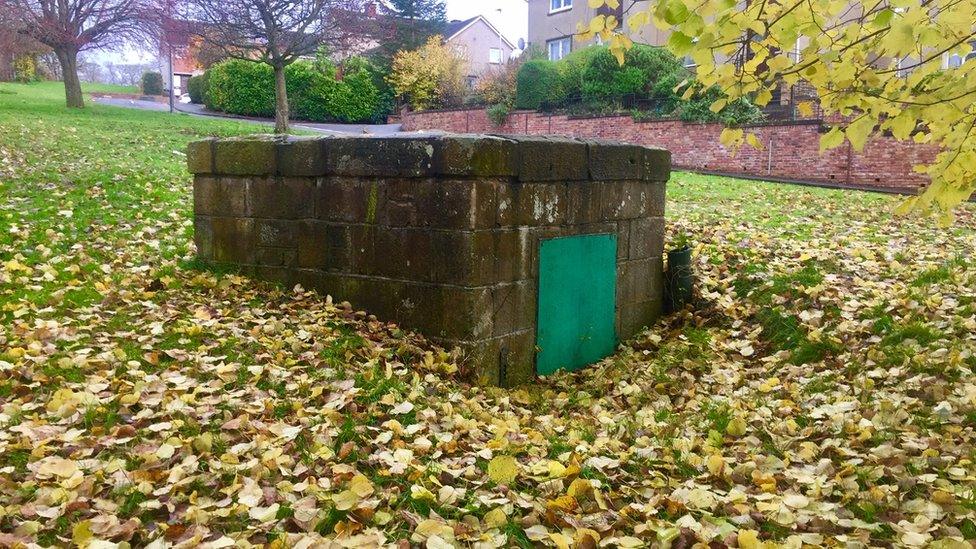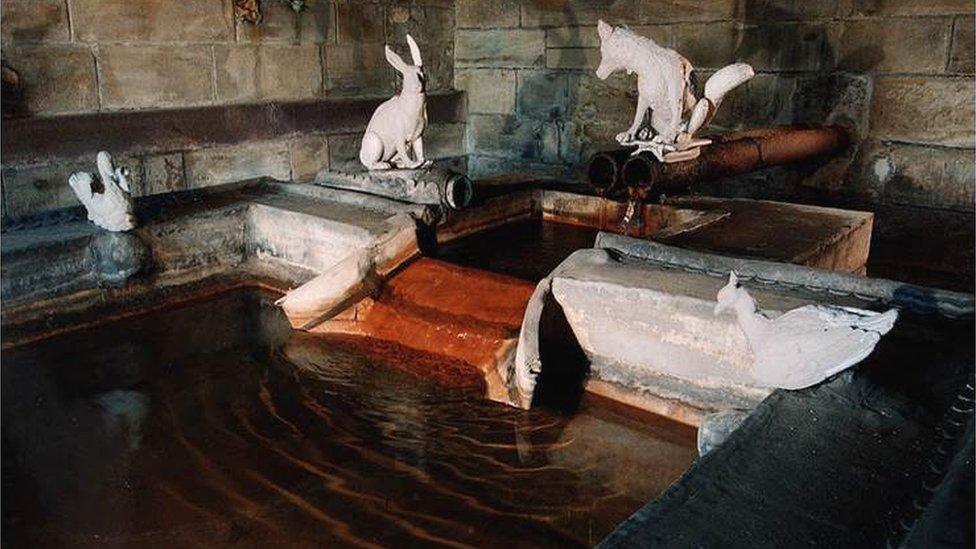Edinburgh's little stone buildings hiding water secrets
- Published

The low-level stone structures can be seen in parkland and residential gardens
Dotted around a suburb of Edinburgh are stone buildings akin to miniature electricity substations - but they don't house a network of wires. They are in fact home to what used to be a key water source for the capital.

These strange-looking stone structures have stood in the Comiston area of Edinburgh for more than 300 years.
Built long before houses, garages, driveways and gardens, they are now integrated into the established residential landscape. But what were they for?
The buildings covered vital spring water that bubbled up from the ground. Before this supply was used, Edinburgh residents could go many weeks without fresh drinking water.
What was available wasn't safe - the Nor' Loch, which had flowed in the valley now occupied by Princes Street Gardens and the Waverley Station, carried typhoid and cholera.
So in 1621 the Scottish Parliament passed an Act "to bring the sweet waters of the country to the centre of Edinburgh".
That prompted the building of the "spring heads" which protected the natural drinking water from contamination.

Each pipe inside Comiston Spring House, which was the main building, had a lead animal on top to mark which spring it was from
George Sinclare, a schoolmaster in Leith, discovered the springs.
He had worked out that Comiston was 60ft higher than a proposed collecting tank at Castlehill, near the Edinburgh Castle Esplanade, meaning the water could travel by gravitation.
There were 27 spring heads established on the estate and the first 10 were given the names of animals, including the hare, the peewit, the fox and the swan.
Edinburgh town council paid £18 a year to The Lady of Comiston for the lease of the springs with the condition the Peewit Spring should be left for the use of farmers for their cattle.
The estate owners of the Barony of Braid were also paid £1,000 to let the pipe pass through their grounds so the water could reach old Edinburgh.
'Unique piece of history'
Each spring fed water to a collecting cistern called Comiston Spring House. This now listed building stands on Cockmylane - the path used by the author Robert Louis Stevenson to reach his house in nearby Swanston.
Pipes from each spring poured into a tank inside Comiston Spring House which filtered the water of debris before it was piped to Edinburgh.
The lead pipes were used up until 1820 when the town council replaced them with 5in cast iron pipes and the springs were decommissioned in 1945, but water still runs through them.
Although they have no practical use now, they remain intact and are looked after by Scottish Water.

Scottish Water's Bill Elliot at the Swan Spring in Oxgangs Loan
Bill Elliot, from the water company, said: "The fact these spring heads are still standing - 340 years on - are testament to the people who designed and built them. Many people have no idea they are there and many who do have no clue of the history behind them.
"In terms of the city's water history their existence is fascinating."
Streets in the area have since been named after the springs, including Swan Spring Avenue, Fox Spring Crescent, Fox Spring Rise and Comiston Springs Avenue.
John Mowat, 86, who has lived next door to the Fox Spring in Comiston View for 50 years said he had no idea the stone buildings had been part of Edinburgh's drinking water history.
After peeking inside one, he said: "When I moved here from Orkney I wondered what it was and then I saw lots of them in the area.
"To be one of the first people to see inside in modern times is very exciting and makes me feel nice to be living next door to such a unique piece of history."
'Like a Roman bath'
John Begbie, 34, janitor at Pentland Primary School in Comiston, said two of the spring heads were on the next door site of the old Hunter's Tryst Primary School, which is now a wasteland.
He said: "I used to play in this area growing up and we just took them for granted as part of the landscape. We knew they were to do with water but we didn't know all the history. We liked them and it's great to think we have such historic monuments in our area."
Simon Johnston, 43, whose house backs on to Comiston Spring House, said he had "always wanted to look inside".
And what was his reaction after taking a look? "I didn't expect there to be this big tank like a Roman bath inside as I thought it would just be the shell of the building. It has exceeded my expectations and is brilliant."

Jojo said he walks past the Fox Spring in Comiston View every day on his way to school
Jojo, 12, who lives in a street nearby, said he walks past the Fox Spring every day on his way to school.
He said: "I've always wondered what it was and what it looked like inside. It's very old and full of cobwebs and rust but I'm surprised how well it has stayed up because you would think all the water would make it crumble after all this time."